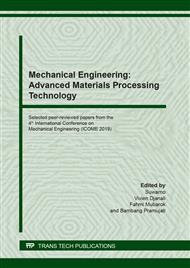[1]
G. Catalan and J. F. Scott, Adv. Mater. 21, 2463 (2009).
Google Scholar
[2]
X.D. Qi, J. Dho, R. Tomov, M. G. Blamire, and J. L. MacManus-Driscoll, Appl. Phys. Lett. 86, 062903 (2005).
DOI: 10.1063/1.1862336
Google Scholar
[3]
Q.Pan, B.Chu, Enhanced magnetoelectric response in bismuth-deficient BiFeO3-BaTiO3 ceramics, Journal of Applied Physics, 125, 154102 (2019).
DOI: 10.1063/1.5086343
Google Scholar
[4]
H.B. Yang, Q.Q. Ke, H.Y. Si, and J.S. Chen, J. Appl. Phys. 111, 024104 (2012).
Google Scholar
[5]
S. Unruan, S. Srilomsak, S. Priya, P. Jantaratana, S. Rujirawat, and R. Yimnirun, Ceram. Int. 41, 4087 (2015).
DOI: 10.1016/j.ceramint.2014.11.103
Google Scholar
[6]
X.C. Wu, M.J. Tian, Y.Q. Guo, Q.J. Zheng, L.L. Luo, and D.M. Lin, J. Mater. Sci. Mater. Electron. 26, 978 (2015).
Google Scholar
[7]
R. Gupta, J. Shah, S. Chaudhary, S. Singh, and R. K. Kotnala, J. Nanopart. Res.15, 2004 (2013).
Google Scholar
[8]
S. C. Yang, A. Kumar, V. Petkov, and S. Priya, J. Appl. Phys. 113, 144101 (2013).
Google Scholar
[9]
S. W. Cheong and M. Mostovoy, Nat. Mater. 6, 13 (2007).
Google Scholar
[10]
K. F. Wang, J. M. Liu, and Z. F. Ren, Adv. Phys. 58, 321 (2009).
Google Scholar
[11]
M. Fiebig, J. Phys. D Appl. Phys. 38, R123 (2005).
Google Scholar
[12]
Y. Tokura and S. Seki, Adv. Mater. 22, 1554 (2010).
Google Scholar
[13]
C. A. F. Vaz, J. Hoffman, C. H. Ahn, and R. Ramesh, Adv. Mater. 22, 2900 (2010).
Google Scholar
[14]
Selbach, S. M., Einarsrud, M. & Grande, T. On the thermodynamic stability of BiFeO3. Chem. Mater. 21, 169–173 (2009).
Google Scholar
[15]
Valant, M., Axelsson, A. & Alford, N. Peculiarities of a solid-state synthesis of multiferroic polycrystalline BiFeO3. Chem. Mater. 19, 5431–5436 (2007).
DOI: 10.1021/cm071730+
Google Scholar
[16]
Leontsev, S. O. & Eitel, R. E. Dielectric and piezoelectric properties in Mn-modified (1-x)BiFeO3–xBaTiO3 ceramics. J. Am. Ceram. Soc. 92, 2957–2961 (2009).
DOI: 10.1111/j.1551-2916.2009.03313.x
Google Scholar
[17]
Guo, Y. et al. Critical roles of Mn-ions in enhancing the insulation, piezoelectricity and multiferroicity of BiFeO3-based lead-free high temperature ceramics. J. Mater. Chem. C 3, 5811–5824 (2015).
DOI: 10.1039/c5tc00507h
Google Scholar
[18]
Joo, H. W., Kim, D. S., Kim, J. S. & Cheon, C. I. Piezoelectric properties of Mn-doped 0.75BiFeO3−0.25BaTiO3 ceramics. Ceram. Int. 42, 10399–10404 (2016).
DOI: 10.1016/j.ceramint.2016.03.179
Google Scholar
[19]
A. Kumar, S. Saha, H. Basumatary, R. Ranjan, Ferromagnetism in the multiferroic alloy systems BiFeO3-BaTiO3 and BiFeO3-SrTiO3: Intrinsic or extrinsic?, Appl. Phys. Lett. 114, 022902 (2019).
DOI: 10.1063/1.5059550
Google Scholar
[20]
G. Catalan and J. F. Scott, Adv. Mater. 21, 2463 (2009).
Google Scholar
[21]
R. Mazumder, P. S. Devi, D. Bhattacharya, P. Choudhury, A. Sen, and M. Raja, Appl. Phys. Lett. 91, 062510 (2007).
DOI: 10.1063/1.2768201
Google Scholar
[22]
T. J. Park, G. C. Papaefthymiou, A. J. Viescas, A. R. Moodenbaugh, and S. S. Wong, Nano. Lett. 7, 766 (2007).
Google Scholar
[23]
T. J. Park, G. C. Papaefthymiou, A. J. Viesca, Y. Lee, H. Zhou, and S. S. Wong, Phys. Rev. B 82, 024431 (2010).
Google Scholar
[24]
A. Singh, V. Pandey, R. K. Kotnala, and D. Pandey, Phys. Rev. Lett. 101, 247602 (2008).
Google Scholar
[25]
S. Vura, P. S. Anil Kumar, A. Senyshyn, and R. Ranjan, J. Magn. Magn. Mater. 365, 76 (2014).
Google Scholar
[26]
Z. Z. Ma, Z. M. Tian, J. Q. Li, C. H. Wang, S. X. Huo, H. N. Duan, and S. L. Yuan, Solid State Sci. 13, 1296 (2011).
Google Scholar
[27]
K. Singh, N. S. Negi, R. K. Kotnala, and M. Singh, Solid State Commun. 148, 18 (2008).
Google Scholar
[28]
B. Xu, D. Wang, J. _I~niguez, and L. Bellaiche, Adv. Funct. Mater. 25, 552 (2015).
Google Scholar
[29]
H. Zheng, J.Wang, S. E. Lofland, Z. Ma, L. M. Ardabili, T. Zhao, L. S. Riba, S. R. Shinde, S. B. Ogale, F. Bai, D. Viehland, Y. Jia, D. G. Schlom, M.Wuttig, A. Roytburd, and R. Ramesh, Science 303, 661 (2004).
DOI: 10.1126/science.1094207
Google Scholar
[30]
D. Suastiyanti, Ismojo, Phase-Pure of BiFeO3 Ceramic Based on Citric Acid –Assisted Gel by Sintering Time Variation, IOP Conf. Series: Materials Science and Engineering 214 (2017).
DOI: 10.1088/1757-899x/214/1/012027
Google Scholar
[31]
D. Suastiyanti, S. Yatmani, M. Wijaya, Magnetic properties of nanomagnetic material based on BaTiO3 and BiFeO3 with variation of temperatures and timesof sintering, IOP Conf. Series: Journal of Physics: Conf. Series 1153 (2019).
DOI: 10.1088/1742-6596/1153/1/012052
Google Scholar
[32]
D. Suastiyanti, M.T.E. Manawan, M. Wijaya, Electric polarization properties of BaTiO3- BiFeO3 as nanomultiferroic material produced by sol-gel method, MATEC Web of Conferences 204, 05005 (2018).
DOI: 10.1051/matecconf/201820405005
Google Scholar


